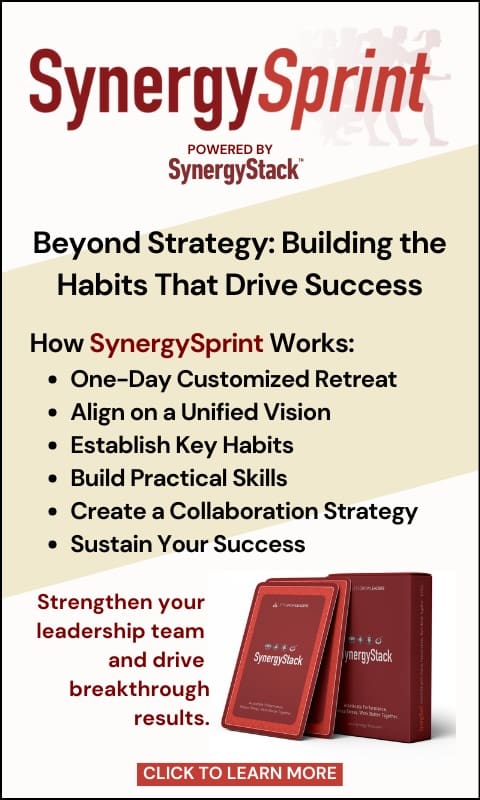Motivate employees to move faster by eliminating roadblocks and managing risk.
Do you ever mutter, “Will they ever get anything done if I don’t follow up? I’m sick of hovering and I’m sure it feels like I’m micromanaging.” Ironically, the higher your sense of urgency, the more you’ll encounter this problem. The solution? A few consistent communication tools will help you motivate employees to meet those deadlines—without constant oversight.
Why Focusing on Urgency Won’t Solve the Problem

Telling your team to “act with urgency” or “be more committed” won’t help them move any faster.
Why not? Because words like “urgency” or “commitment” mean different things to different people. (On a scale of 1—10, David’s sense of urgency is an 8 while Karin’s sense of urgency is an 11. We can both claim we’re acting with urgency, but Karin will usually be faster.)
And if you want proof that people have different definitions of “urgent,” go ask five people to define the word “soon.” You’ll get five different answers.
Your people see their work differently than you do. Some value speed. Others value quality. Still others focus on impact or process.
Instead of focusing on vague words like “urgent,” you can motivate employees to move faster (and lower your stress) through a few consistent communication habits and removing barriers to speed.
5 Essential Communication Skills to Motivate Employees to Have More Urgency
When you want to build a culture where people move at a crisp pace, your first job is to eliminate misunderstanding. You can help everyone get on the same page and quickly deal with conflicting priorities by using these communication tools.
1. Schedule the Finish
If you’re a high-urgency leader and you’re frustrated with your team, this conversation will solve many of your problems.
Stop leaving follow-through to good intentions, will power, or different interpretations of “soon.” Instead, schedule the finish.
Scheduling the finish means you have a conversation about feasibility and competing priorities. The conversation ends with an appointment for follow-through at a specific time, listed on the calendar of everyone involved.
When you schedule the finish, there are two types of tasks that need your focus: routine tasks and delegated assignments.
Schedule the Finish for Routine Tasks
These routine tasks can be frustrating. You might think, “This is part of your job—why can’t you just get it done?” If that sounds familiar, try grouping these routine tasks into buckets and setting shared deadlines.
Here’s the key question: with no extra conversation between you and your team, if we asked them, “What does your manager expect in terms of when these tasks should be done?” would they give me the same answer you would?
(Not sure what they’d say? Ask them—their answers might surprise you!)
If everyone agrees about what success looks like, great. But if their answers differ from yours or they seem unsure, it’s time to set clear expectations for each bucket of work.
You can apply the same approach to ongoing tasks, too. The goal might be something like “finish this weekly.” For example, if an employee handles customer contact and needs to document conversations and actions, you could aim for 100% completion by the end of the day every Wednesday and Friday.
Schedule the Finish for Delegated Assignments
Your team members constantly decide where to put their time. A clear finish line with mutual accountability helps everyone make better decisions.
For example, you have a conversation with one of your team members about following up on a customer complaint. She agrees the customer issue needs investigation.
Before you leave the conversation, you say, “Let’s schedule the finish. Can you and your team investigate what happened, then make suggestions on how we can address it by Friday at 3?”
Your team member mentions another project that’s due that same afternoon. Upon reflection, you decide the customer issue is more important and give her team until Tuesday to complete the first project, so they have time to deal with the customer’s issue.
You conclude the conversation by making an appointment on your calendars for 3 pm Friday, when she will brief you on their findings.
2. Check for Understanding
This next communication tool to create a culture of timeliness reduces misunderstandings. Check for understanding means to ensure that everyone in a conversation has the same comprehension of what you agreed.
Checking for understanding is not asking “Do you understand?” Instead, you might say, “Before we wrap up, let’s check for understanding. What are we doing next? What’s our goal here? And when are we meeting to follow up?”
3. 5 x 5 Communication
Any message that is critical to your team’s success requires consistent communication. 5 x 5 communication means that you communicate critical content at least five times through five different channels.
This repetition and variety ensure that everyone internalizes the message.
5 x 5 communication will help you reinforce not only when things should be done, by more importantly: WHY that timeframe is critical
4. Address Conflicting Values and Priorities
One way you can unintentionally frustrate your employees is by creating conflict and expecting them to resolve it. Leaders do this all the time because every value or priority will conflict with another value or priority at some point.
An easy example is the tension between urgency and quality. You can always do something faster – if you are willing to sacrifice quality. How should your employees resolve this tension?
The worst thing you can do is leave them to their own devices and then get upset when they don’t make the decision you would prefer.
Instead, address these conflicts head on. Own them. Talk about them. Have senior leaders tell strategic stories about how you’ve dealt with these conflicts in the past and how you hope your team will resolve them in the future.
5. Close the Loop with Celebration and Accountability
Early in my (David’s) career, the CEO asked me to take on a special project. He had a clear finish line, and I worked evenings and through the weekend on top of my regular work to get it done.
When I (quite proudly) brought the finished project to him, he looked confused. I reminded him what he had asked me to do. He laughed and said, “Oh, we’re not doing that anymore. We’re going a different direction.”
Ouch.
You can probably imagine that I didn’t treat his future requests with the same urgency.
This was a pretty awful example of not closing the loop.
Every time you ask something of your team, you create an open loop. You have an intention—and you fulfill that intent. Or you don’t.
Either way, you need to close the loop. If the team did it, celebrate. Acknowledge their work. And if they didn’t do it, have an accountability conversation. See what the team can learn. Can they get it done now? Or learn something to help for the future?
Closing the loop builds momentum. It tells your team that you truly value their follow-through.
Motivate Employees by Removing Roadblocks
Roadblock #1—A Missing “Why”
Your team needs to understand the reason for their work. What’s the why? A missing why creates roadblocks to urgency because other tasks with well-understood “whys” will take priority.
Use your 5 x 5 communication strategy to answer the questions your team is asking: What business purpose does this urgency serve? How does it improve the customer or employee experience?
Connecting timelines to meaningful reasons “why” will also help you avoid the next roadblock…
Roadblock #2—False Urgency (or Everything’s Urgent)
You lose credibility when everything is urgent. Soon, your people tune out your requests. “Oh, everything’s always a last-minute emergency with him. Don’t worry about it.”
As soon as people can’t take you seriously, you’ve become a barrier to timeliness.
Roadblock #3—Risk Aversion
We once spoke with a vice president who told us, “I’d rather be late and get it right than early and wrong. I’ll get yelled at for being late, but our President loses his s*** if I make a mistake.”
This President was also frustrated that his team didn’t move quickly enough. He was his own roadblock.
How do you respond to mistakes?
Your people pay attention to your responses.
You might say you don’t want them to spend tons of time building giant decks filled with microscopic columns of data. But if you get angry when they don’t have a specific number at their fingertips, they’ll ignore what you say and pay attention to what you do.
Remove this roadblock by clarifying risk tolerance and celebrating healthy risk—especially when it doesn’t work out.
What is the range of accuracy you expect in their reports or assignments? Clarify acceptable risk up front and treat mistakes as learning opportunities.
Roadblock #4 – Managers Don’t Understand or Aren’t Accountable for Their Communication
 Do you feel like your team has a good sense of urgency, but you struggle to motivate employees throughout your organization to move quickly? If so, this roadblock is certainly part of your problem.
Do you feel like your team has a good sense of urgency, but you struggle to motivate employees throughout your organization to move quickly? If so, this roadblock is certainly part of your problem.
Equip your managers with the five communication skills in this article and hold them accountable for using these tools. When your team consistently schedules the finish, checks for understanding, communicates key messages five times, five different ways, addresses values and priority conflicts, and practices accountability and celebration, your culture will improve.
Urgency at a Human Scale
People can’t work at speed or with high stress forever. Part of the reason you have a conversation when you schedule the finish is to ensure that workloads are manageable. But even then, a culture of urgency can burnout your best employees and undermine long term success. Here are three suggestions to help you avoid these pitfalls and practice urgency at a human scale.
1. Know Your Race
When you run a 100-meter sprint, you run as fast as you can for the full race (under 10 seconds if you’re a male Olympian sprinter).
But when you run 100-kilometer ultramarathon, you don’t sprint. You don’t run anywhere near as fast. In fact, you might even stop running to eat a snack.
What race are you running? There are times to sprint. And there are times to “run” at a more sustainable pace, take breaks, and rest. Help motivate your employees with a sense of urgency appropriate to the “race” they’re running.
2. Don’t Use Urgency to Address Problems with Process or Systems
If you have constant “fire drills” or “all-hands-on-deck” scrambles to deal with problems, you’ll burnout your team.
Instead of using urgency to address problems repeatedly, solve the problem. The first time it happens, yes, you need to respond. But now you know it’s an issue. What process or system do you need to fix to prevent it happening again?
Focus on long-term solutions that save urgency for when you really need it. Your team will have energy to respond and trust you when you ask for it.
3. Engage your Team and Ask Them for Their I.D.E.A.s
A final way to practice urgency at a human scale is by helping your team to own challenges and solutions.
Do you need to accelerate a project? Create a consistent scheduled finish for routine tasks? Find a faster way to get your customer what they need?
Start by defining the opportunity and why it matters. Then ask your team for their solutions. “Here’s why this is important—how do you think we can do it?”
You can give them the I.D.E.A. model to help them contribute quality suggestions:
I—Why is the idea Interesting and strategically relevant?
D—How is the idea Doable?
E—Who do they need to Engage to make the idea work?
A—What are the specific one or two next Actions to implement the idea?
You’ll get more meaningful ideas. Your team will own the improvements – and often come up with better solutions than you could.
Your Turn
We encourage you to be your own consultant: go ask your team for their understanding of timetables and why critical tasks are done when they are. Explore the gaps. Use the communication skills, remove the roadblocks, and build your culture.
And of course, we love working with organizations like yours to help you infuse these communication skills, motivate employees, and build a culture where people thrive. If we can help, give us a call or write us.








0 Comments